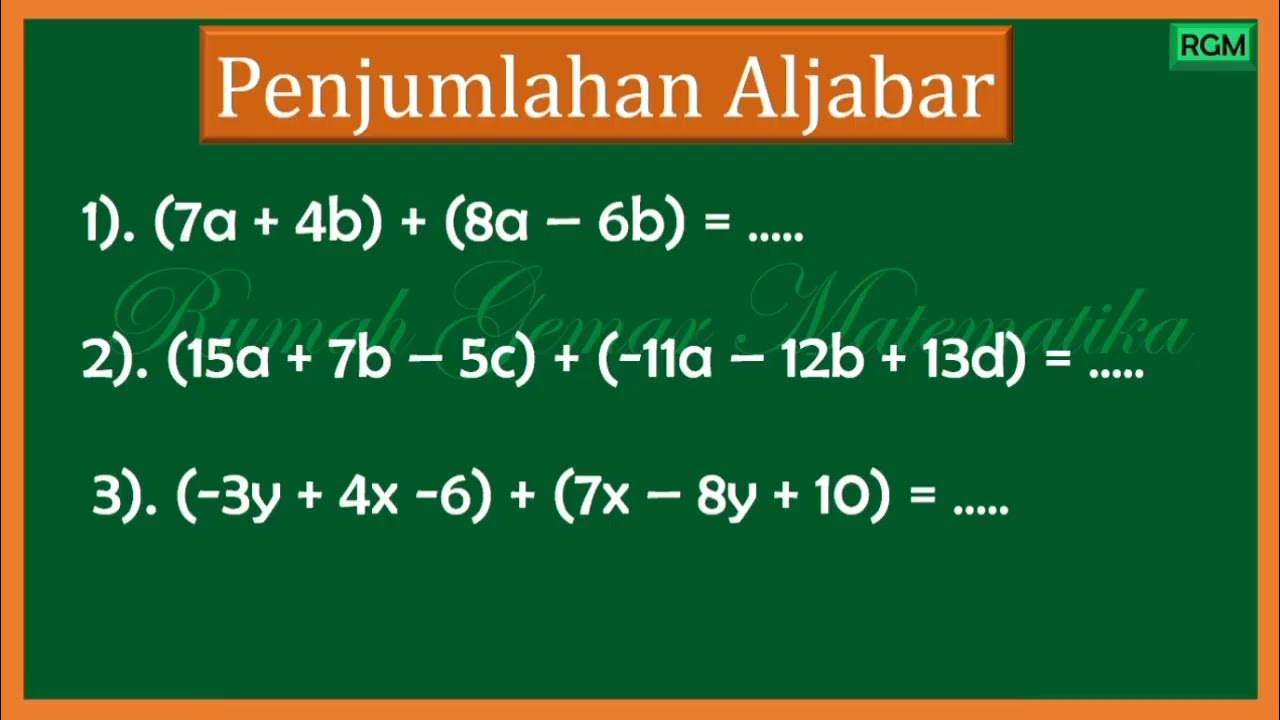How to simplify an expression by combining like terms and the distributive property | Khan Academy
Summary
TLDRIn this video, the speaker simplifies algebraic expressions using basic arithmetic principles. They first demonstrate the distributive property by simplifying 2 times (3x + 5) into 6x + 10. Then, they tackle a more complex expression, 7 times (3y - 5) - 2 times (10 + 4y), showing step-by-step distribution and combining like terms to arrive at the simplified result of 13y - 55. The video emphasizes foundational concepts like distribution and combining similar terms to help viewers understand the process of simplification in algebra.
Takeaways
- 😀 The previous video feedback suggested the use of less overwhelming Chuck Norris imagery, and this video aims for a more soothing approach.
- 😀 The goal is to simplify expressions, applying previously known ideas in a more accessible way.
- 😀 Simplifying the expression 2 times (3x + 5) involves distributing the 2 to both terms inside the parentheses.
- 😀 Distributing 2 to 3x gives 6x, and distributing 2 to 5 gives 10, resulting in the simplified expression 6x + 10.
- 😀 The distributive property, which applies when multiplying a number outside parentheses to terms inside, is used throughout this process.
- 😀 A more complex example is given: simplifying 7 times (3y - 5) minus 2 times (10 + 4y).
- 😀 Distributing 7 to both 3y and -5 results in 21y and -35, respectively, simplifying the left side of the expression.
- 😀 On the right side, distributing -2 to both 10 and 4y results in -20 and -8y, respectively.
- 😀 After distributing, we simplify like terms: 21y and -8y combine to give 13y.
- 😀 Finally, combining -35 and -20 results in -55, giving the fully simplified expression 13y - 55.
Q & A
What does the expression 2 times (3x + 5) mean?
-The expression 2 times (3x + 5) means two 3x + 5's, or in other words, adding 3x + 5 twice.
How can we simplify 2 times (3x + 5)?
-To simplify 2 times (3x + 5), we distribute the 2 to both terms inside the parentheses: 2 times 3x equals 6x, and 2 times 5 equals 10. This results in 6x + 10.
Is this simplification an application of the distributive property?
-Yes, this simplification uses the distributive property, where 2 is distributed to both 3x and 5 in the expression 2 times (3x + 5).
What happens when we simplify the expression 7 times (3y - 5)?
-When simplifying 7 times (3y - 5), we distribute the 7 to both terms inside the parentheses: 7 times 3y equals 21y, and 7 times -5 equals -35. The simplified expression is 21y - 35.
How do we handle the expression -2 times (10 + 4y)?
-We distribute the -2 to both terms inside the parentheses: -2 times 10 equals -20, and -2 times 4y equals -8y. The result is -20 - 8y.
What is the significance of the negative sign in -2 times (10 + 4y)?
-The negative sign means that both 10 and 4y will be multiplied by -2, which results in -20 and -8y, respectively.
What is the final simplified form of the expression 7 times (3y - 5) - 2 times (10 + 4y)?
-The final simplified form of the expression is 13y - 55. This is achieved by combining like terms: 21y - 8y equals 13y, and -35 - 20 equals -55.
Why can't we combine the terms 21y and -35 or -20 in the expression 21y - 35 - 20?
-We cannot combine the terms 21y and -35 or -20 because they represent different types of terms: 21y is a term involving y, while -35 and -20 are constant numbers.
How do you combine like terms in the expression 21y - 8y?
-To combine like terms, simply subtract the coefficients: 21y - 8y equals 13y. Both terms involve the variable y, so they can be combined.
Why is the distributive property important in simplifying algebraic expressions?
-The distributive property is important because it allows us to multiply a number by each term inside parentheses, simplifying the expression step by step and making it easier to work with.
Outlines

This section is available to paid users only. Please upgrade to access this part.
Upgrade NowMindmap

This section is available to paid users only. Please upgrade to access this part.
Upgrade NowKeywords

This section is available to paid users only. Please upgrade to access this part.
Upgrade NowHighlights

This section is available to paid users only. Please upgrade to access this part.
Upgrade NowTranscripts

This section is available to paid users only. Please upgrade to access this part.
Upgrade NowBrowse More Related Video

PT3 KSSM Mathematics Form 1 (Algebraic Expressions) Chapter 5 Complete Revision

Pembahasan Tes Kemampuan Akademik (TKA)|Kelas XII Matematika Wajib-1

Belajar Matematika Dasar: Pengenalan Metode Aljabar(seri 040)

Aljabar | Matematika Kelas 7 Kurikulum Merdeka - Lengkap

What is meant by Factorising? What is a Factor? | ExamSolutions

CARA MENGHITUNG PENJUMLAHAN ALJABAR #aljabar
5.0 / 5 (0 votes)